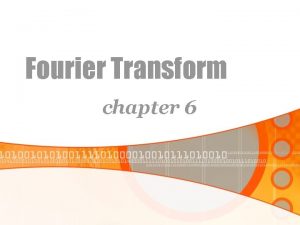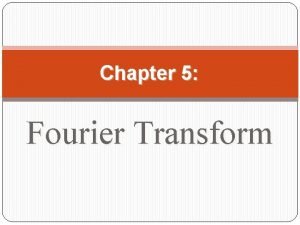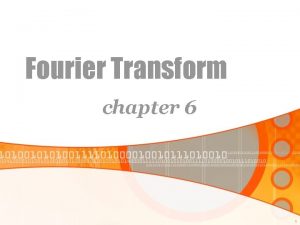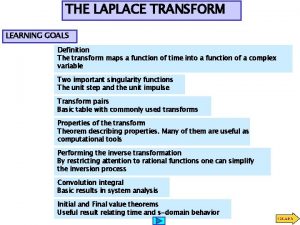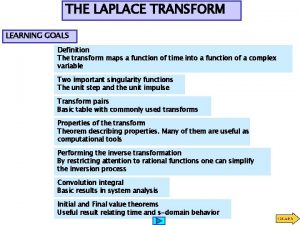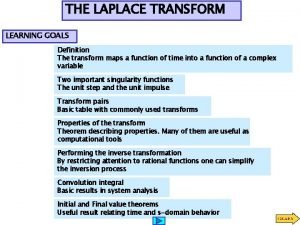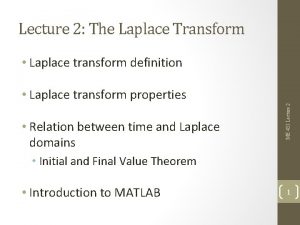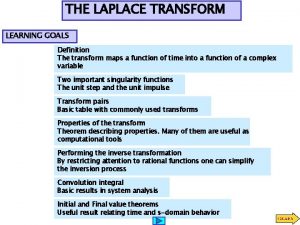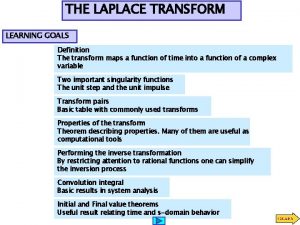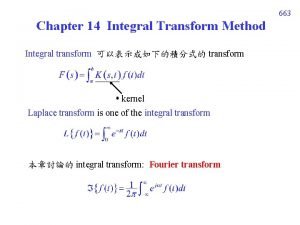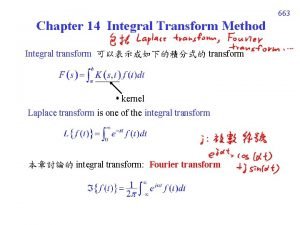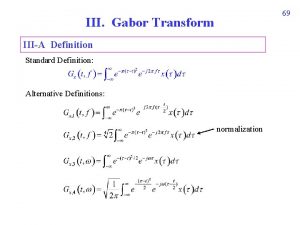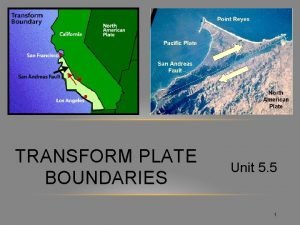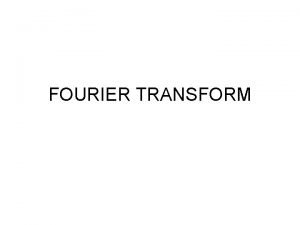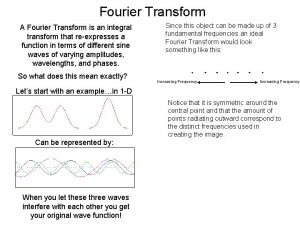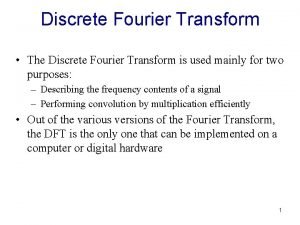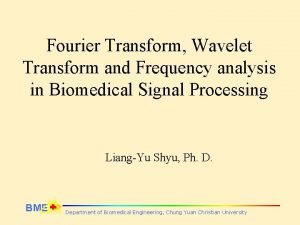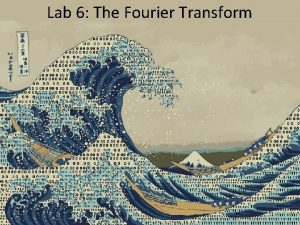Chapter 5 The Z Transform 1 Definition 2





























- Slides: 29

Chapter 5 The Z Transform 1. Definition 2. Properties of the z-Transform 3. Inverse z-Transform 4. Solution of Difference Equations Using the z-Transform CEN 352, Dr. Nassim Ammour, King Saud University 1

From DFT to Z-transform Generalizing DFT Z-transform Add module r All the complex space Eigen function Unit circle in the complex space input Output (convolution) Z-transform input Output CEN 352, Dr. Nassim Ammour, King Saud University 2

Z - Transform Introduction • The Z-transform plays the same role in the analysis of discrete-time signals and LTI systems as the Laplace transform does in the continuous-time signals and LTI systems. • It offers the techniques for digital filter design and frequency analysis of digital signals. Definition of z-transform: Z Where z is a complex variable For a causal sequence: All the values of z that make the summation to exist form a region of convergence (ROC). CEN 352, Dr. Nassim Ammour, King Saud University 3

Example 1 Problem: Solution: From the definition of the z-transform: ROC: Region of Convergence (values of z for the convergence) we know, Therefore, When, CEN 352, Dr. Nassim Ammour, King Saud University 4

Example 2 Problem: Solution: From the definition of the z-transform Since this is a geometric series Therefore, Region of Convergence that will converge for, CEN 352, Dr. Nassim Ammour, King Saud University 5

Z-Transform Table CEN 352, Dr. Nassim Ammour, King Saud University 6

Problem: Example 3 Find the z-transform for each of the following sequences: a. b. Solution: a. From line 9 in the Table: b. From line 14 in the Table: CEN 352, Dr. Nassim Ammour, King Saud University 7

Z-Transform Properties (1) Linearity: Example 4 Problem: Find the z-transform of Solution: Applying the linearity of the z-transform Using z-transform Table Line 3 Therefore, we get, Line 6 CEN 352, Dr. Nassim Ammour, King Saud University 8

Z-Transform Properties (2) Z-Transform Shift Theorem: Verification: Then we achieve, CEN 352, Dr. Nassim Ammour, King Saud University 9

Problem: Example 5 Determine the z-transform of Solution: Using shift theorem, Using z-transform table, line 6: CEN 352, Dr. Nassim Ammour, King Saud University 10

Z-Transform Properties (3) Convolution eq. (1) In time domain, In Z-transform domain, Verification: Taking the z-transform of eq. (1) CEN 352, Dr. Nassim Ammour, King Saud University 11

Example 6 Problem: Given the sequences, Find the z-transform of the convolution. Solution: Applying the z-transform of the two sequences, Therefore we get, CEN 352, Dr. Nassim Ammour, King Saud University 12

Inverse z-Transform: Examples Example 7 Find the inverse z-transform of Solution We get, Using table, Example 8 Solution Find the inverse z-transform of We get, Using table, CEN 352, Dr. Nassim Ammour, King Saud University 13

Inverse z-Transform: Examples Example 9 Find the inverse z-transform of Solution Since, From line 9 in the Table By coefficient matching, Therefore, Example 10 Find the inverse z-transform of Solution Using Table CEN 352, Dr. Nassim Ammour, King Saud University 14

Inverse z-Transform: Using Partial Fraction CEN 352, Dr. Nassim Ammour, King Saud University 15

Inverse z-Transform: Using Partial Fraction Problem: Find the inverse z-transform of Example 11 Solution: First eliminate the negative power of z. Dividing both sides by z, Finding the constants: Therefore, inverse z-transform is: CEN 352, Dr. Nassim Ammour, King Saud University 16

Inverse z-Transform: Using Partial Fraction Problem: Example 12 Solution: Dividing Y(z) by z, Applying the partial fraction expansion, We first find B: Next find A: CEN 352, Dr. Nassim Ammour, King Saud University 17

Example 12 –contd. Using the polar form, Now we have: Therefore, the inverse z-transform is: from Line 15 in Table CEN 352, Dr. Nassim Ammour, King Saud University 18

Inverse z-Transform: Using Partial Fraction Problem: Example 13 Solution: Dividing both sides by z: Where, Using the formulas for mth-order, m=2, p=0. 5 CEN 352, Dr. Nassim Ammour, King Saud University 19

Example 13 –contd. Then, From Table, Finally we get, CEN 352, Dr. Nassim Ammour, King Saud University 20

Partial Fraction Expansion Using MATLAB Problem: Find the partial expansion of Example 14 Solution: The denominator polynomial can be found using MATLAB: Therefore, and MATLAB performs the partial fraction expansion The solution is: residues poles direct term CEN 352, Dr. Nassim Ammour, King Saud University 21

Partial Fraction Expansion Using MATLAB Problem: Find the partial expansion of Example 15 Solution: CEN 352, Dr. Nassim Ammour, King Saud University 22

Partial Fraction Expansion Using MATLAB Problem: Find the partial expansion of Example 16 Solution: Then CEN 352, Dr. Nassim Ammour, King Saud University 23

Difference Equation Using Z-Transform • The procedure to solve difference equation using Z-Transform: 1. Apply the z-transform to the difference equation. 2. Substitute the initial conditions. 3. Solve for the difference equation in the z-transform domain. 4. Find the solution in the time domain by applying the inverse z-transform. CEN 352, Dr. Nassim Ammour, King Saud University 24

Problem: Example 17 Solution: We have Taking z-transform on both sides: Substituting the initial condition and z-transform on right hand side using Table: Arranging Y(z) on left hand side: CEN 352, Dr. Nassim Ammour, King Saud University 25

Example 17 –contd. Solving for A and B: Therefore, Taking inverse z-transform, we get the solution: CEN 352, Dr. Nassim Ammour, King Saud University 26

Problem: Example 18 A DSP system is described by the following differential equation with zero initial condition: Solution: a. Applying the z-transform on both sides: Applying On right side CEN 352, Dr. Nassim Ammour, King Saud University 27

Example 18 –contd. We multiply the numerator and denominator by z 2 Using the partial fraction expansion Solving for A and B: Therefore, Hence the impulse response: CEN 352, Dr. Nassim Ammour, King Saud University 28

Example 18 –contd. b. The input is step unit function: Corresponding z-transform: Notice that [Slide 27] Using the partial fraction expansion and the system response is found by using Table: CEN 352, Dr. Nassim Ammour, King Saud University 29
 Hát kết hợp bộ gõ cơ thể
Hát kết hợp bộ gõ cơ thể Ng-html
Ng-html Bổ thể
Bổ thể Tỉ lệ cơ thể trẻ em
Tỉ lệ cơ thể trẻ em Chó sói
Chó sói Glasgow thang điểm
Glasgow thang điểm Hát lên người ơi
Hát lên người ơi Môn thể thao bắt đầu bằng chữ f
Môn thể thao bắt đầu bằng chữ f Thế nào là hệ số cao nhất
Thế nào là hệ số cao nhất Các châu lục và đại dương trên thế giới
Các châu lục và đại dương trên thế giới Công của trọng lực
Công của trọng lực Trời xanh đây là của chúng ta thể thơ
Trời xanh đây là của chúng ta thể thơ Cách giải mật thư tọa độ
Cách giải mật thư tọa độ 101012 bằng
101012 bằng độ dài liên kết
độ dài liên kết Các châu lục và đại dương trên thế giới
Các châu lục và đại dương trên thế giới Thể thơ truyền thống
Thể thơ truyền thống Quá trình desamine hóa có thể tạo ra
Quá trình desamine hóa có thể tạo ra Một số thể thơ truyền thống
Một số thể thơ truyền thống Cái miệng nó xinh thế chỉ nói điều hay thôi
Cái miệng nó xinh thế chỉ nói điều hay thôi Vẽ hình chiếu vuông góc của vật thể sau
Vẽ hình chiếu vuông góc của vật thể sau Nguyên nhân của sự mỏi cơ sinh 8
Nguyên nhân của sự mỏi cơ sinh 8 đặc điểm cơ thể của người tối cổ
đặc điểm cơ thể của người tối cổ V cc
V cc Vẽ hình chiếu đứng bằng cạnh của vật thể
Vẽ hình chiếu đứng bằng cạnh của vật thể Tia chieu sa te
Tia chieu sa te Thẻ vin
Thẻ vin đại từ thay thế
đại từ thay thế điện thế nghỉ
điện thế nghỉ Tư thế ngồi viết
Tư thế ngồi viết
































